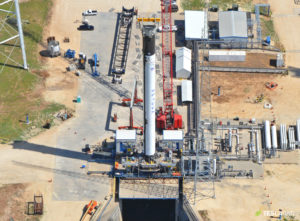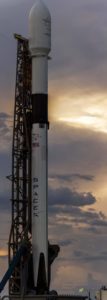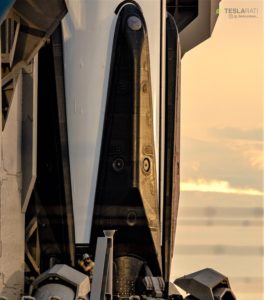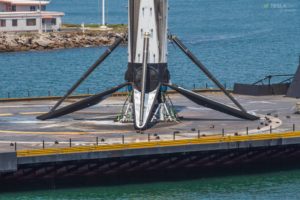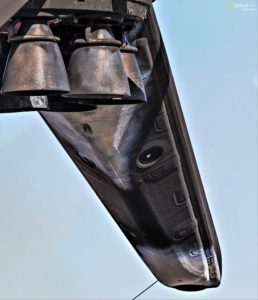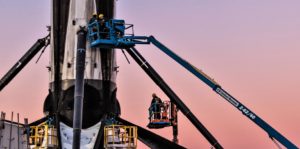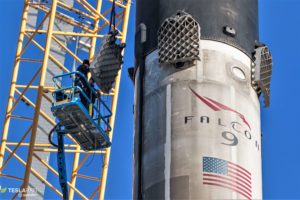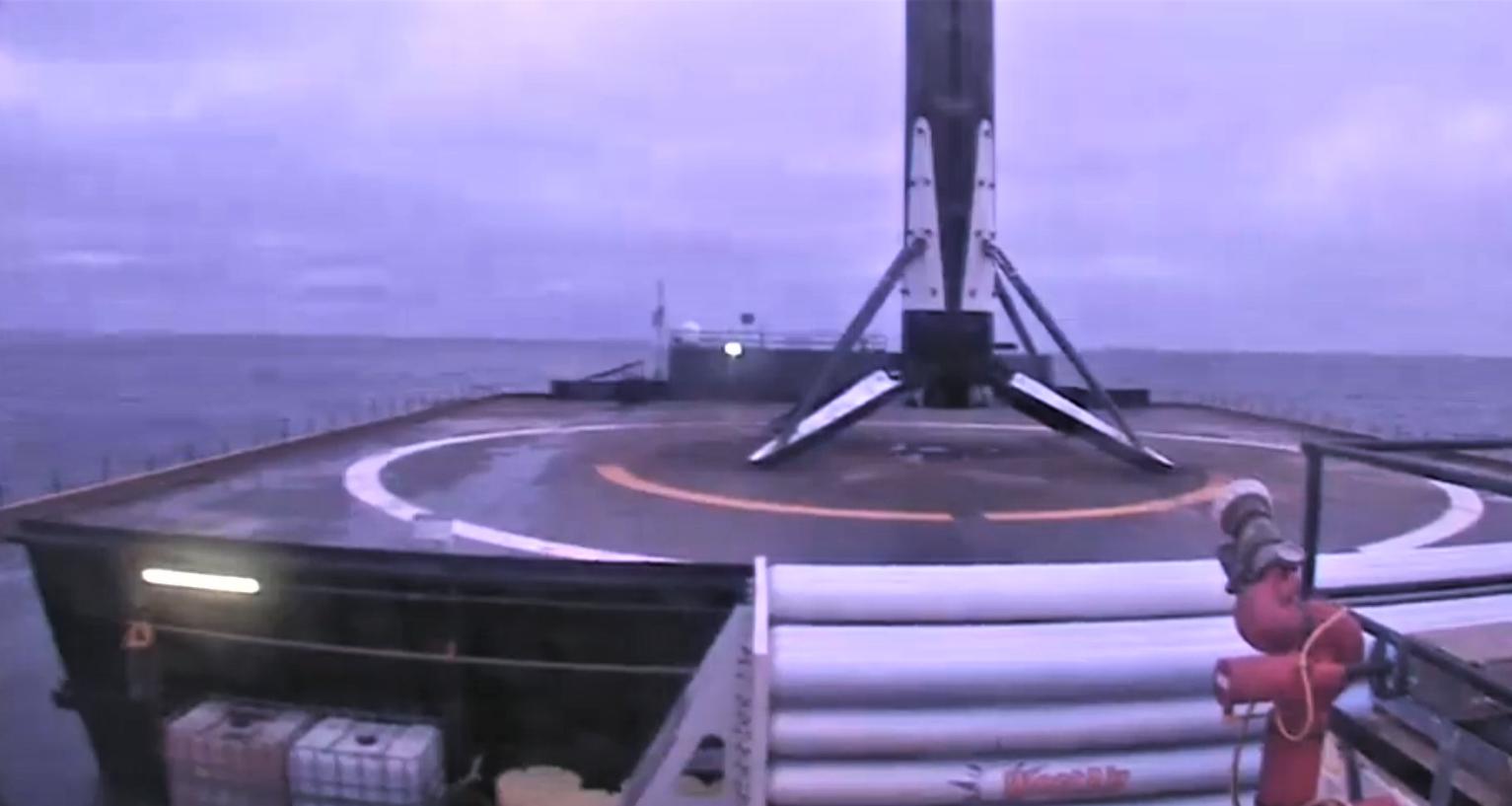

News
SpaceX’s first Falcon 9 landing of 2019 foreshadows rapid rocket fleet growth
Despite an unplanned landing anomaly that foiled SpaceX’s last Falcon 9 recovery attempt, the company’s engineers and technicians have pulled off another successful launch and landing of Falcon 9 – the 33rd for the rocket family – and the first of the new year.
After helping place Iridium’s 8th and final set of NEXT satellites into a parking orbit, Falcon 9 B1049 landed aboard drone ship Just Read The Instructions approximately 7 minutes after liftoff, marking the Block 5 booster’s second successful mission in just under four months. As of now, all but one of SpaceX’s flight-ready Falcon 9 boosters have now performed two or three orbital-class launches and are quickly becoming a truly reusable fleet of rockets.
Webcast of Falcon 9 launch to complete the @IridiumComm NEXT constellation is now live → https://t.co/gtC39uBC7z pic.twitter.com/lU3TwSeCbz
— SpaceX (@SpaceX) January 11, 2019
Throughout the second half of 2018, SpaceX gradually built, tested, launched, and relaunched a growing fleet of Falcon 9 Block 5 boosters, the first of which debuted in May. Including new boosters that have arrived at their launch pads but have yet to launch, SpaceX’s skilled production and testing team managed to ship, test, and deliver an impressive 1 to 1.5 Falcon 9 boosters, 1-2 upper stages, and 3-4 payload fairing halves on average each month. Thanks to Falcon 9 Block 5’s increasingly exceptional reusability, SpaceX does not have to outproduce other companies and national space programs to dramatically out-launch them, exemplifed by the fact that SpaceX alone was able to launch more orbital missions than the combined output of every company and country aside from China.
As more Falcon 9 and Falcon Heavy Block 5 booster are introduced into SpaceX’s growing fleet, the company’s many distinct advantages of direct and indirect competitors should come more and more into play and be increasingly difficult to avoid or ignore. As of today, a fairly incredible number of additional new Falcon boosters are already in their testing and delivery phases, a number that ignores the four (or five) flight-proven boosters and two unflown Falcons known to already be at or ready to ship to launch sites.
- SpaceX’s second Falcon 9 Block 5 booster was spied by an aerial photographer in Texas, April 17. (Aero Photo)
- Falcon 9 Block 5 will be absolutely critical to the success (and even the basic completion) of Starlink. (Tom Cross)
- The second Block 5 booster, B1047, debuted at LC-40 on July 21. (Tom Cross)
- SpaceX’s third Falcon 9 Block 5 booster successfully returned to Port of Los Angeles aboard drone ship Just Read The Instructions (JRTI) on July 27th. (Pauline Acalin)
- It’s unclear what exactly causes it, but Falcon 9 Block 5’s newly heat-shielded legs turn a rather bright white after being scorched during booster landings. (Pauline Acalin)
- Falcon 9 B1046.3. (Pauline Acalin)
- SpaceX technicians remove Falcon 9 B1046’s titanium grid fins after its historic third launch and landing, December 2018. (Teslarati – Pauline Acalin)
- Falcon 9 B1046 became the first SpaceX booster to launch three separate times in early-December 2018. (Pauline Acalin)
Just for Falcon Heavy’s second and third launches (NET March and April), SpaceX will deliver another two boosters (one side and one center) to Florida within the next ~6 weeks and will likely ship, test, and deliver another two or three new Falcon 9 boosters in the first half of 2019 for commercial missions and two crewed Crew Dragon launches scheduled for the second half of the year. Although Falcon Heavy’s new side boosters will likely remain side boosters for both of the rocket’s next missions, that should mean that they will be free enter the single-stick Falcon 9 fleet sometime in H2 2019, as will the three new boosters assigned to Crew Dragon this year. Falcon Heavy’s center core will remain dedicated to Falcon Heavy launches as a result of the extensive modifications necessary to support triple the thrust of a normal Falcon 9.
Regardless, this ultimately means that SpaceX’s reusable Falcon fleet could feature as many as 12-15 boosters capable of something like 5-10 additional launches each by the second half of fourth quarter of 2019. At that point, SpaceX might have enough experience with Block 5 and enough flight-proven boosters to plausibly begin a revolutionary shift in how commercial launches are done. With far more boosters available than SpaceX has payloads to launch, multiple flight-ready Block 5 rockets will inevitably stack up at or around the company’s three launch pads and surrounding integration and refurbishment facilities.
Liftoff of Iridium-8 from Vandenberg AFB. Gorgeous morning to end a beautiful launch campaign. 🚀 pic.twitter.com/RZPRRV9i5t
— Pauline Acalin (@w00ki33) January 11, 2019
Instead of the current process of launch where boosters are dedicated to certain missions in fairly iron-clad terms, SpaceX could conceivably treat its launch services as actual services, meaning that – aside from requests for unflown hardware or customer-specific standards (i.e. USAF/NASA/NRO) – the specifics of booster assignments would be no more of a worry to customers than the cargo plane goods are delivered with matters to 99% of logistics customers. A plane is typically a plane regardless of whether it has flown for 10 hours or 10,000 hours. That sort of interchangeability and hands-off approach to customers is likely at least 12 months off, if not longer (old habits die hard), but a fleet of a dozen or more flight-ready rockets is truly a brave new world for commercial spaceflight and even spaceflight in general.
For prompt updates, on-the-ground perspectives, and unique glimpses of SpaceX’s rocket recovery fleet check out our brand new LaunchPad and LandingZone newsletters!
News
Tesla launches in India with Model Y, showing pricing will be biggest challenge
Tesla finally got its Model Y launched in India, but it will surely come at a price for consumers.

Tesla has officially launched in India following years of delays, as it brought its Model Y to the market for the first time on Tuesday.
However, the launch showed that pricing is going to be its biggest challenge. The all-electric Model Y is priced significantly higher than in other major markets in which Tesla operates.
On Tuesday, Tesla’s Model Y went up for sale for 59,89,000 rupees for the Rear-Wheel Drive configuration, while the Long Range Rear-Wheel Drive was priced at 67,89,000.
This equates to $69,686 for the RWD and $78,994 for the Long Range RWD, a substantial markup compared to what these cars sell for in the United States.
🚨 Here’s the difference in price for the Tesla Model Y in the U.S. compared to India.
🚨 59,89,000 is $69,686
🚨 67,89,000 is $78,994 pic.twitter.com/7EUzyWLcED— TESLARATI (@Teslarati) July 15, 2025
Deliveries are currently scheduled for the third quarter, and it will be interesting to see how many units they can sell in the market at this price point.
The price includes tariffs and additional fees that are applied by the Indian government, which has aimed to work with foreign automakers to come to terms on lower duties that increase vehicle cost.
Tesla Model Y seen testing under wraps in India ahead of launch
There is a chance that these duties will be removed, which would create a more stable and affordable pricing model for Tesla in the future. President Trump and Indian Prime Minister Narendra Modi continue to iron out those details.
Maharashtra Chief Minister Devendra Fadnavis said to reporters outside the company’s new outlet in the region (via Reuters):
“In the future, we wish to see R&D and manufacturing done in India, and I am sure at an appropriate stage, Tesla will think about it.”
It appears to be eerily similar to the same “game of chicken” Tesla played with Indian government officials for the past few years. Tesla has always wanted to enter India, but was unable to do so due to these import duties.
India wanted Tesla to commit to building a Gigafactory in the country, but Tesla wanted to test demand first.
It seems this could be that demand test, and the duties are going to have a significant impact on what demand will actually be.
Elon Musk
Tesla ups Robotaxi fare price to another comical figure with service area expansion
Tesla upped its fare price for a Robotaxi ride from $4.20 to, you guessed it, $6.90.

Tesla has upped its fare price for the Robotaxi platform in Austin for the first time since its launch on June 22. The increase came on the same day that Tesla expanded its Service Area for the Robotaxi ride-hailing service, offering rides to a broader portion of the city.
The price is up from $4.20, a figure that many Tesla fans will find amusing, considering CEO Elon Musk has used that number, as well as ’69,’ as a light-hearted attempt at comedy over the past several years.
Musk confirmed yesterday that Tesla would up the price per ride from that $4.20 point to $6.90. Are we really surprised that is what the company decided on, as the expansion of the Service Area also took effect on Monday?
But the price is now a princely $6.90, as foretold in the prophecy 😂
— Elon Musk (@elonmusk) July 14, 2025
The Service Area expansion was also somewhat of a joke too, especially considering the shape of the new region where the driverless service can travel.
I wrote yesterday about how it might be funny, but in reality, it is more of a message to competitors that Tesla can expand in Austin wherever it wants at any time.
Tesla’s Robotaxi expansion wasn’t a joke, it was a warning to competitors
It was only a matter of time before the Robotaxi platform would subject riders to a higher, flat fee for a ride. This is primarily due to two reasons: the size of the access program is increasing, and, more importantly, the service area is expanding in size.
Tesla has already surpassed Waymo in Austin in terms of its service area, which is roughly five square miles larger. Waymo launched driverless rides to the public back in March, while Tesla’s just became available to a small group in June. Tesla has already expanded it, allowing new members to hail a ride from a driverless Model Y nearly every day.
The Robotaxi app is also becoming more robust as Tesla is adding new features with updates. It has already been updated on two occasions, with the most recent improvements being rolled out yesterday.
Tesla updates Robotaxi app with several big changes, including wider service area
News
Tesla Model Y and Model 3 dominate U.S. EV sales despite headwinds
Tesla’s two mainstream vehicles accounted for more than 40% of all EVs sold in the United States in Q2 2025.

Tesla’s Model Y and Model 3 remained the top-selling electric vehicles in the U.S. during Q2 2025, even as the broader EV market dipped 6.3% year-over-year.
The Model Y logged 86,120 units sold, followed by the Model 3 at 48,803. This means that Tesla’s two mainstream vehicles accounted for 43% of all EVs sold in the United States during the second quarter, as per data from Cox Automotive.
Tesla leads amid tax credit uncertainty and a tough first half
Tesla’s performance in Q2 is notable given a series of hurdles earlier in the year. The company temporarily paused Model Y deliveries in Q1 as it transitioned to the production of the new Model Y, and its retail presence was hit by protests and vandalism tied to political backlash against CEO Elon Musk. The fallout carried into Q2, yet Tesla’s two mass-market vehicles still outsold the next eight EVs combined.
Q2 marked just the third-ever YoY decline in quarterly EV sales, totaling 310,839 units. Electric vehicle sales, however, were still up 4.9% from Q1 and reached a record 607,089 units in the first half of 2025. Analysts also expect a surge in Q3 as buyers rush to qualify for federal EV tax credits before they expire on October 1, Cox Automotive noted in a post.
Legacy rivals gain ground, but Tesla holds its commanding lead
General Motors more than doubled its EV volume in the first half of 2025, selling over 78,000 units and boosting its EV market share to 12.9%. Chevrolet became the second-best-selling EV brand, pushing GM past Ford and Hyundai. Tesla, however, still retained a commanding 44.7% electric vehicle market share despite a 12% drop in in Q2 revenue, following a decline of almost 9% in Q1.
Incentives reached record highs in Q2, averaging 14.8% of transaction prices, roughly $8,500 per vehicle. As government support winds down, the used EV market is also gaining momentum, with over 100,000 used EVs sold in Q2.
Q2 2025 Kelley Blue Book EV Sales Report by Simon Alvarez on Scribd
-

 News3 days ago
News3 days agoTesla debuts hands-free Grok AI with update 2025.26: What you need to know
-

 Elon Musk1 week ago
Elon Musk1 week agoElon Musk confirms Grok 4 launch on July 9 with livestream event
-

 Elon Musk5 days ago
Elon Musk5 days agoxAI launches Grok 4 with new $300/month SuperGrok Heavy subscription
-

 News2 weeks ago
News2 weeks agoTesla Model 3 ranks as the safest new car in Europe for 2025, per Euro NCAP tests
-

 Elon Musk2 weeks ago
Elon Musk2 weeks agoxAI’s Memphis data center receives air permit despite community criticism
-

 News5 days ago
News5 days agoTesla begins Robotaxi certification push in Arizona: report
-

 Elon Musk2 weeks ago
Elon Musk2 weeks agoTesla reveals it is using AI to make factories more sustainable: here’s how
-

 Elon Musk2 weeks ago
Elon Musk2 weeks agoTesla scrambles after Musk sidekick exit, CEO takes over sales

